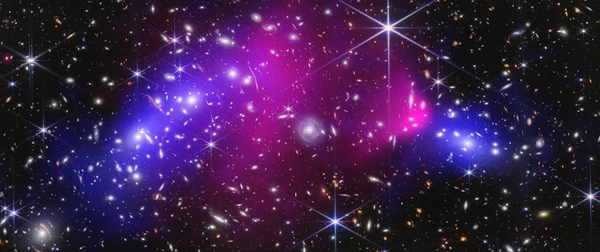
Dark matter is one of the greatest mysteries of modern physics. Invisible, it emits neither light nor detectable radiation, but its gravitational influence is measurable throughout the Universe. According to current cosmological models, about 27% of the Universe's energy content consists of this unknown matter, compared to just 5% for ordinary baryonic matter.
The existence of dark matter was first suggested by Fritz Zwicky (1898-1974) in 1933, while studying the velocities of galaxies in the Coma Cluster. He found that the visible mass was insufficient to keep the cluster gravitationally bound. Later, in the 1970s, Vera Rubin (1928-2016) measured the rotation curve of spiral galaxies. Contrary to Kepler's law, which predicts a decrease in velocity with radius, Rubin observed that the velocity stabilized, implying the presence of a dominant invisible mass.
The Bullet Cluster (1E 0657–56), located about 3.7 billion light-years away, is considered direct evidence of dark matter's existence. This cluster is the result of the collision of two galaxy clusters (see image), whose analysis combines X-ray data (in red) and gravitational lensing effects (in blue).
Observations by the Chandra satellite show extremely hot gas (temperature > 108 K), which radiates intensely in X-rays. This gas (in red), which makes up most of the visible baryonic mass of the clusters, is strongly slowed by pressure forces during the collision. It thus accumulates in the center, between the two clusters.
The total mass distribution was measured using the gravitational lensing effect on background galaxies. Surprisingly, the gravitational mass is offset from the baryonic gas and is concentrated around the galaxies themselves, on either side of the gas region (in blue).
This clear separation between baryonic matter (hot gas, red in the image) and the dominant gravitational mass (dark matter, blue) is considered irrefutable proof that the observed gravity cannot be explained by visible matter alone. It also contradicts modified gravity models like MOND, which predict that the mass distribution should follow that of baryonic matter.
The Bullet Cluster thus stands as a cornerstone in favor of the standard cosmological model, known as ΛCDM, where about 27% of the Universe's energy content is attributed to dark matter.
Dark matter plays a central role in the evolution of the Universe:
| Hypothesis | Physical Nature | Typical Mass | Domain of Action | Advantages | Limitations |
|---|---|---|---|---|---|
| WIMPs | Weakly interacting massive particles | 10 GeV – 10 TeV | Cosmology and galactic dynamics | Predicted by extensions of the Standard Model (SUSY), abundance compatible with thermal calculations from the Big Bang | Not detected despite decades of direct and indirect experiments |
| Axions | Ultra-light particles | 10-6 to 10-2 eV | Cosmology, stellar astrophysics | Can solve the strong CP problem: the introduction of a Peccei-Quinn symmetry breaks spontaneously, driving the QCD θ parameter to zero; the quantum excitation of this field is the axion | Depend on photon-axion conversion experiments (ADMX, CAST), uncertain cosmological abundance parameter |
| MACHOs | Massive compact halo objects (brown dwarfs, primordial black holes) | 0.1 – 10 M☉ | Galactic halos | Simple astrophysical explanation, observable via gravitational microlensing | Population too small to explain total dark matter, statistically limited detection |
| Sterile Neutrinos | Hypothetical non-interacting neutrinos | keV – MeV | Cosmology, structure formation | Can explain warm dark matter, affect the formation of small structures | Constrained by X-ray radiation and cosmological data, still speculative model |
| MOND | Modification of Newton's laws at low acceleration | No particle | Galactic dynamics | Accurately explains galactic rotation curves without dark matter | Incompatible with cosmology (CMB, cluster formation), no physical detection |
| Additional Exotic Particles | E.g., gravitinos, superparticles from SUSY | 10 GeV – 1 TeV | Early universe, galactic halos | Can be long-term stable and explain observed abundance | Extremely difficult to detect, highly model-dependent |
Sources: Bertone & Tait, Nature 2022, Particle Data Group 2024, ESA Planck Mission, Bahcall et al. 1999.